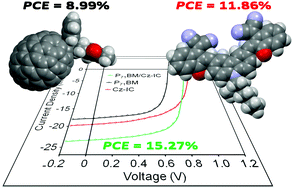Efficient ternary bulk heterojunction organic solar cells using a low-cost nonfullerene acceptor†
Abstract
In order to improve the power conversion efficiency of single junction polymer solar cells (PSCs), we have used a ternary blend consisting of a low bandgap D–A conjugated polymer P and two acceptors, i.e., one nonfullerene, Cz-IC, and one fullerene, PC71BM. The concept of a ternary bulk heterojunction (BHJ) using these two acceptors takes advantage of the high electron mobility of the fullerene, which is beneficial for charge transport. The absorption spectra of PC71BM, Cz-IC and P are complementary to each other, resulting in an increase in the light harvesting ability of the ternary BHJ active layer. The PSC based on an optimized ternary BHJ active layer achieved a PCE of 15.27%, which is higher than those of both binary PSCs based on P:PC71BM and P:Cz-IC. The increase in JSC and FF values for the ternary PSC with respect to the P:Cz-IC binary counterpart may be attributed to the better and balanced charge transport properties owing to the high electron mobility of PC71BM. The incorporation of PC71BM into the P:Cz-IC blend also increases the hole transfer efficiency from both acceptors to P, thus reducing the charge recombination, resulting in a boost of the fill factor and the overall PCE of the ternary OSC.



 Please wait while we load your content...
Please wait while we load your content...